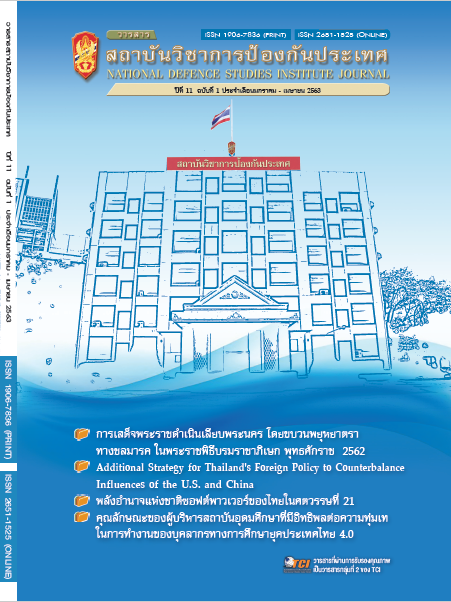An Improvement of the Strategic Intelligence Curriculum of Armed Forces Security Center
Main Article Content
Abstract
The purposes of this research were to 1) analyze the changing political, economic and social contexts in order to develop and improve the subject matter to be up-to-date in accordance with the inside and outside country strategic environment that affect Thailand and for the Security Center, Royal Thai Armed Forces Headquarters is ready for the organization's mission, 2) evaluate the strategic intelligence
curriculum according to CIPP Model evaluation and 3) develop the proposal of the strategic intelligence curriculum in order to improve officers of intelligence departments to Royal Thai Armed Forces Headquarters, Royal Thai Army, Royal Thai Navy, Royal Thai Air Force, government officers, and civil officers. The research was mixed method, the combination of quantitative and qualitative research, by using document studies data collection by questionnaires and in-depth interviews in the population of 3 study groups which were 1) 146 Strategic Intelligence curriculum students (Class 40-50) 2) 40 people who were executives, instructors and students who studied the strategic intelligence curriculum (Class 51) 3) 18 Strategic Intelligence and Security experts and 4) In-depth interviews of administrators, course instructors, delegates, and strategic intelligence program students (Class 51) and 38 experts in strategic intelligence and security work.
The results of the curriculum evaluation based on the CIPP Model assessment in all aspects showed that the overall level was at the higher and highest level of agreement. The course remains consistent with the political, economic and social contexts as according to the mission of Armed Force Security Center, but there are proposals to add the course content to 6 key points which are 1) draft of 20-year National Strategy (2017-2036) 2) non-traditional threats, national power, global strategic circumstances Headquarters. in the present era and in the future 3) political, economic and social context that have changed rapidly 4) globalization era 5) modern technology of intelligence departments 6) 8 compliments of strategic intelligence. Additional proposals for system development should be made from the lecturers, the cuntents of the subjects, and the learning management environment to be consistent.
Article Details
The articles, images, tables, graphs, written content, and opinions published in this journal are solely those of the authors and do not necessarily reflect the views or positions of the National Defence Studies Institute or its academic affiliates.
References
ธำรง บัวศรี. (2542). ทฤษฎีหลักสูตรการออกแบบและการพัฒนา. กรุงเทพฯ: คุรุสภา.
ประวัติโรงเรียนรักษาความปลอดภัย ศูนย์รักษาความปลอดภัย กองบัญชาการทหารสูงสุด. (2548). กรุงเทพฯ: ศูนย์รักษาความ
ปลอดภัย กองบัญชาการทหารสูงสุด.
ภาณุศิลป์ กลั่นเสนาะ. (2556). แนวทางการพัฒนาหลักสูตรข่าวกรองทางยุทธศาสตร์ของกองบัญชาการกองทัพไทย. กรุงเทพฯ:
วิทยาลัยป้องกันราชอาณาจักร สถาบันวิชาการป้องกันประเทศ.
รัตนะ บัวสนธ์. (2556). รูปแบบการประเมิน CIPP และ CIPIEST มโนทัศน์ที่คลาดเคลื่อนและถูกต้องในการใช้. สืบค้นจาก
http://www.rattanabb.com/html/CIPP.pdf
วิชัย วงษ์ใหญ่. (2540). การประเมินหลักสูตรแบบครบวงจร. กรุงเทพฯ: รุ่งเรืองธรรม.
วิทยาลัยป้องกันราชอาณาจักร สถาบันวิชาการป้องกันประเทศ. คู่มือใช้เป็นแนวทางในการศึกษาตามหลักสูตรของวิทยาลัยป้องกันราช
อาณาจักร (เอกสาร วปอ. หมายเลข 009) คู่มือการพัฒนายุทธศาสตร์ชาติ. (2561). กรุงเทพฯ: วิทยาลัยป้องกันราชอาณาจักร
สถาบันวิชาการป้องกันประเทศ.
ศูนย์รักษาความปลอดภัย กองบัญชาการทหารสูงสุด. (2532). คู่มือข่าวกรองทางยุทธศาสตร์ โรงเรียนรักษาความปลอดภัย ศูนย์รักษา
ความปลอดภัย (หมายเลข ขกศ. 1-1001). กรุงเทพฯ: ศูนย์รักษาความปลอดภัย กองบัญชาการทหารสูงสุด.
สงัด อุทรานันท์. (2532). พื้นฐานและหลักการพัฒนาหลักสูตร. กรุงเทพฯ: วงเดือนการพิมพ์.
สุนีย์ ภู่พันธ์. (2546). แนวคิดพื้นฐานการสร้างและพัฒนาหลักสูตร. เชียงใหม่: เดอะ โนเลส เซ็นเตอร์.
สุรชาติ บำรุงสุข. (2558). ความมั่นคงใหม่ ความเปลี่ยนแปลงและความท้าทาย. กรุงเทพฯ: โครงการความมั่นคงศึกษา สถาบันการข่าว
กรอง สำนักงานข่าวกรองแห่งชาติ.
อดุลย์ กอวัฒนา. (2543). แนวความคิดในการพัฒนางานข่าวกรองทางยุทธศาสตร์ของไทย. กรุงเทพฯ: วิทยาลัยป้องกันราชอาณาจักร
สถาบันวิชาการป้องกันประเทศ.
อรอนงค์ บุญแผน. (2552). การพัฒนาหลักสูตรสถานศึกษา กลุ่มสาระการเรียนรู้วิทยาศาสตร์ หน่วยการเรียนรู้สายน้ำแห่งชีวิต ชั้น
ประถมศึกษาปีที่ 6 โรงเรียนบ้านมูกมันโนนอุดมสามัคคี สำนักงานเขตพื้นที่การศึกษา นครราชสีมา เขต 6 (ปริญญานิพนธ์
ปริญญามหาบัณฑิต). มหาวิทยาลัยราชภัฏนครราชสีมา.
Kittiwara. (2017). การพัฒนาหลักสูตร. สืบค้นจาก
http://kittiwaratme.blogspot.com/2017/01/development-2-2-taba-good-2-saylor- and.html
Krongkon Bumrungveth. (2014). การประเมินผลหลักสูตร. สืบค้นจาก
http://krongkon06550065.blogspot.com/2014/12/blog- post_59.html
Ngamchatturat, Thanatcha. (2017). สรุปองค์ความรู้เรื่องการพัฒนาหลักสูตร. สืบค้นจาก
http://thanatcha06550036.blogspot.com/2015/05/blog-post.html
Patil, Y., & Kalekar, S. (2015). CIPP MODEL FOR SCHOOL EVALUATION. Retrieved
from http://oaji.net/articles/2015/1201-1439207905.pdf
Sowell, E. J. (1996). Curriculum An Integrative Introduction. New Jersey: Prentic-Hall.
Stufflebeam, D. L. (2007). CIPP EVALUATION MODEL CHECKLIST (2nd ed). Retrieved from
https://wmich.edu/sites/default/files/attachments/u350/2014/cippchecklist_mar07.pdf


